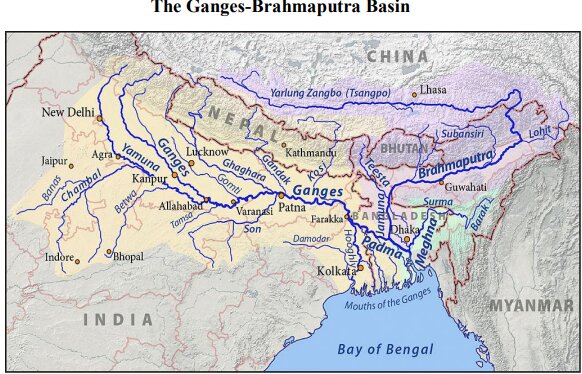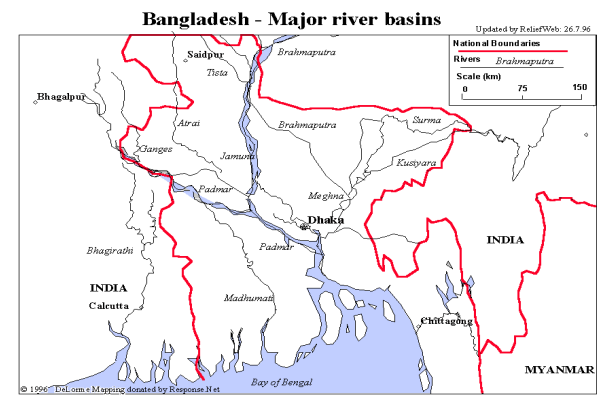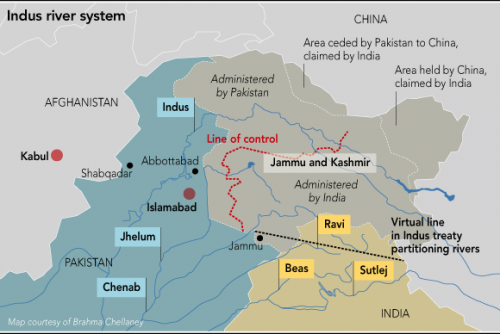International Relations
Trans-Boundary Water Conflicts
- 28 Jun 2019
- 13 min read
Context
- With about 4% of the water resources of the world, India should have been a water-adequate nation. However, in 2011 India turned into a water-stressed nation.
- India is currently ranked 120 among 122 countries on the Water Quality Index, as per a report by NITI Aayog.
- It uses the largest amount of groundwater - 24% of the global total, more than that of China and the US combined.
- UN reports estimates that by 2030, water demand in India will grow to almost 1.5 trillion cubic metres from approximately 740 billion cubic metres (2010 estimate).
- This situation is further aggravated by the India’s water disputes with its neighbours and inter-state river water disputes in India.
India’s Water Disputes with its Neighbours
- Water remains a politically contested issue in much of South Asia. The region is facing water shortage and agrarian difficulties, and it will continue to face increasing demands on energy and water with rapid industrialisation.
- Over-extraction of groundwater is of particular concern, with an estimated 23 million pumps in use across Bangladesh, India, Nepal and Pakistan.
- Moreover, salinity and arsenic contamination affects over 60% of groundwater in the Indo-Gangetic plain.
- Combine these factors with the impact of climate change that’s reducing the amount of water in the Brahmaputra basin and changing the patterns of water flow.
- Under such circumstances, the increasing need for power and stable water levels could prompt reconsideration in bilateral water-sharing treaties in future.
India-China Water Dispute
- Both Brahmaputra and the glaciers that feed Ganga originate in China. As an upstream riparian region, China maintains an advantageous position and can build infrastructure to intentionally prevent water from flowing downstream.
- Owing to previous tendencies where the Chinese have been reluctant to provide details of its hydro-power projects, there is a trust deficit between the two neighbours.
- China’s dam-building and water division plans along the Brahmaputra (called Yarlung Zangbo in China) is a source of tension between the two neighbours, despite the two having signed several MoUs on strengthening communication and strategic trust.
- As lower riparian countries, India and Bangladesh rely on the Brahmaputra’s water for agriculture.
- China has now plans to build four more dams on the Brahmaputra in Tibet. Both India and Bangladesh worry that these dams will give Beijing the ability to divert or store water in times of political crisis.
- India, for its part, has built dams on the Teesta River, a tributary of the Brahmaputra, to utilise the flow of the Teesta during the dry season.
India–Bangladesh
- Sharing the waters of the Teesta river, which originates in the Himalayas and flows through Sikkim and West Bengal to merge with the Brahmaputra in Assam and (Jamuna in Bangladesh), is perhaps the most contentious issue between two friendly neighbours, India and Bangladesh.
- The river covers nearly the entire floodplains of Sikkim, while draining 2,800 sq km of Bangladesh, governing the lives of hundreds of thousands of people.
- For West Bengal, Teesta is equally important, considered the lifeline of half-a-dozen districts in North Bengal.
- Bangladesh has sought an “equitable” distribution of Teesta waters from India, on the lines of the Ganga Water Treaty of 1996 (an agreement to share surface waters at the Farakka Barrage near their mutual border), but to no avail.
- In 2015, Prime Minister Narendra Modi’s visit to Dhaka has generated some expectations to take forward the previous issues on fair and equitable water sharing agreement.
- But Teesta remains an unfinished project, as in India individual states have significant influence over transboundary agreements. This arrangement sometimes impedes the policymaking process. For example, one of the key stakeholders of the Teesta agreement, West Bengal is yet to endorse the deal.
India–Nepal
- Water cooperation between Nepal and India have been agreements signed on major rivers like Kosi, Gandaki, Karnali or Mahakali, essentially for large hydroelectric and irrigation projects by building dams or barrages.
- No project except the Kosi barrage has been completed yet. Smaller rivers have also been ignored.
- Since 1954, when the Kosi Agreement was signed between India and Nepal, talks between the two governments have stalled and water rights issues have not been addressed.
- There have been various disputes over this agreement fuelled by floods in the Kosi region.
- India and Nepal have also had disputes over the issue of compensation of the Kosi dam.
- Moreover, Nepal had considered India’s construction as an encroachment on Nepal’s territorial sovereignty.
- The problem with the Kosi River is its high level of sedimentation and embankments have proven to be ineffective to tackle the sedimentation.
- The only available option in this case is storage tanks and these cannot be set up without the cooperation of Nepal.
- India and Nepal have traditionally disagreed over the interpretation of the Sugauli Treaty signed in 1816 between the British East India Company and Nepal, which delimited the boundary along the Maha Kali River in Nepal.
- India and Nepal differ as to which stream constitutes the source of the river.
- The dispute between India and Nepal might seem minor but it gains strategic importance, because the disputed area lies near the Sino‐Indian border.
India–Pakistan Water Dispute
- Both India and Pakistan since partition have experienced friction over various water conflicts.
- The countries early leaders anticipated this fierce rivalry over the waters that connect their volatile border.
- As a result, after numerous dialogues and through careful negotiations, both countries signed an accord called the Indus Waters Treaty in 1960, which clearly determined how the region’s rivers are to be divided.
- In this treaty, control over three eastern rivers of the Beas, Ravi and Sutlej was given to India, while Pakistan got the control over western rivers of the Indus, Chenab and Jhelum.
- The Indus Waters Treaty has been widely hailed as a success, having survived three post-independence wars between the two hostile neighbours.
- However, the situation for Pakistan has changed significantly from 1960s till the present moment, as it is now on the brink of water scarcity.
- The source or flow of all of the Pakistan’s rivers pass through India first, so this naturally provides India with an upper hand in controlling the outflow of these rivers.
- The Indian Government has more than 40 projects that are either already completed or in the proposal stage on the western rivers. The carrying of such activities within the western rivers has irked Pakistan.
- On the other hand, India keeps dismissing these accusations of Pakistan as baseless and without any scientific backing.
- In 2005, Pakistan challenged India’s 450 MW Baglihar dam project on the Chenab river before the World Bank, but lost the case in the end.
- In 2011, both countries went head to head again at the International Court of Arbitration (ICA) over India’s 330 MW project in Kishanganga project in Jammu and Kashmir.
- The latest dispute is over hydroelectric projects that India is building along the Chenab River. According to Pakistan, these projects violate the treaty and will impact its water supply.
India–Bhutan
- India and Bhutan hydro-electric power cooperation started more than five decades ago.
- Initially, the cooperation was based on the development of small-scale hydro projects such as Tala, Chukha and Kurichu.
- Bhutan has the potential to generate 30,000 MW of hydro-power.
- In 2006, both countries inked a Power Purchase Agreement for thirty five years that would allow India to generate and import 5000 MW of hydro-power from Bhutan, the quantum of which increased to 10,000 MW in 2008.
- On the other hand, the people of Bhutan raised objections to such projects on their long run effects in the country.
- For instance, if Bhutan ever decides to construct storage projects, issues will get intense and more problematic when it comes to dealing with India.
- The internal challenge in Bhutan is water accessibility.
Conclusion
- Everyday policy concerns like water sharing and usage often receive less attention, are combined with larger security or border concerns, or are dealt with only when natural disasters occur. Yet water politics has far-reaching consequences for the prosperity and security of countries.
- While this transboundary issue is integral to the national development policies of these countries, it needs better analysis and understanding on the part of the countries involved in transboundary water sharing agreements.
- The water disputes in South Asian subcontinent deal with the complex orientation of the rivers of the region that cut across some countries in the region complemented by a tense and uncompromising geo-political situation amongst the fellow riparian countries brings out the strategic role played by water in the region.
- Through some critical debates on these agreements and by the active participation of regional organization and mutual understanding among shareholders, these issues could be addressed in the light of experience.
- Near-term hydro diplomacy in south asia could start with less sensitive areas like
- managing flooding by sharing forecasting data
- collaborating on navigation, electricity generation, and water quality
- If successful, these types of less formal cooperation might eventually make countries more willing to consider an official multilateral forum, which (despite some limitations) could help them further build trust, resolve grievances, and manage shared waterways.







